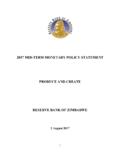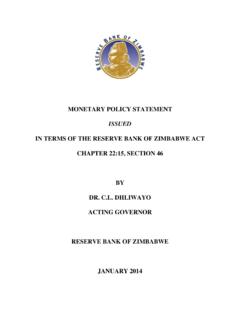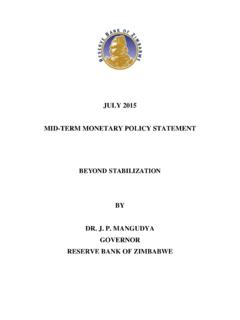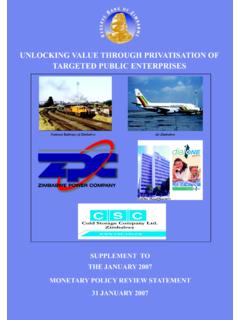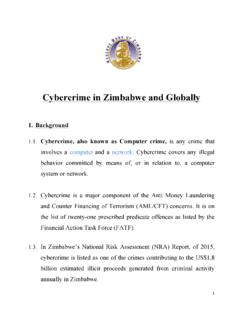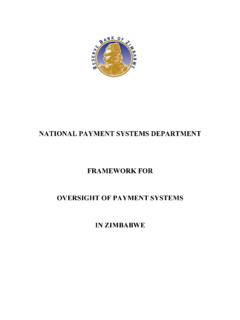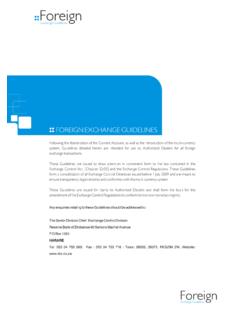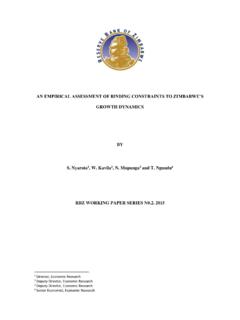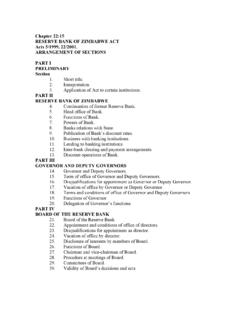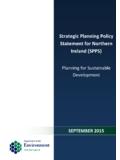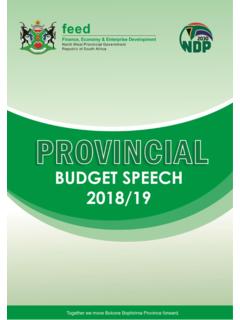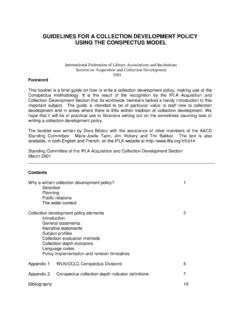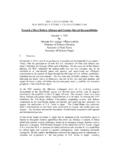Transcription of JANUARY 2018 MONETARY POLICY STATEMENT …
1 JANUARY 2018 MONETARY POLICY STATEMENT ENHANCING FINANCIAL STABILITY TO PROMOTE BUSINESS CONFIDENCE RESERVE BANK OF ZIMBABWE BY DR. J P. MANGUDYA GOVERNOR 2 CONTENTS SECTION 1 .. 4 INTRODUCTION AND EXECUTIVE SUMMARY .. 4 SECTION 2 .. 7 EVALUATION OF 2017 MONETARY POLICY INTEVENTIONS .. 7 SECTION 3 .. 20 GLOBAL AND REGIONAL ECONOMIC DEVELOPMENTS .. 20 SECTION 4 .. 23 BALANCE OF PAYMENTS DEVELOPMENTS .. 23 SECTION 5 .. 28 MONETARY AND INFLATION DEVELOPMENTS .. 28 SECTION 6 .. 35 FINANCIAL SECTOR DEVELOPMENTS .. 35 SECTION 7 .. 45 POLICY MEASURES TO ENHANCE FINANCIAL STABILITY AND TO PROMOTE BUSINESS CONFIDENCE IN THE ECONOMY .. 45 SECTION 8 .. 55 CONCLUSION .. 55 3 LIST OF FIGURES Figure 1: Distribution of Payments Systems Volumes 2017 .. 11 Figure 2: Payment Systems Values for 2017 .. 11 Figure 3: Total RTGS Transactional Activities from 2009 to 2017.
2 12 Figure 4: Total Electronic Transactional Payments from 2009 to 2017 .. 12 Figure 5: SIRESS Transaction Values (ZAR billion) .. 14 Figure 6: Cumulative Credit Redistry Inquiries as at 31 Dec 2017 .. 18 Figure 7: Commodity Price Indices (2010=100): 2012 to November 2017 .. 21 Figure 8: Merchandise Exports and Imports (US$ m) .. 23 Figure 9: Balance of Payments Developments: 2009-2017 .. 24 Figure 10: MONETARY Developments .. 28 Figure 11:Composition of Broad Money .. 29 Figure 12: Average Monthly RTGS Account Balances .. 30 Figure 13: Annual Inflation Profile (%) .. 31 Figure 14: Sectoral Distribution of Loans as at 31 December Figure 15: Trend in Non-Performing Loans 2011 December 2017 .. 39 Figure 16: Prudential Liquidity Ratio Trend (%) .. 40 Figure 17: Growth of Active & Women Clients .. 44 LIST OF TABLES Table 1: Cumulative Export Incentives (5 May 2016 31 December 2017).
3 8 Table 2: Payment System Transactional Activities for 2016 and 2017 .. 10 Table 3: Payment Access Points and Devices for 2016 and 2017 .. 13 Table 4: Gold Deliveries to FPR from JANUARY to December 2017 .. 15 Table 5: Financial Inclusion Indicators Dec 2016-2017 .. 15 Table 6: Global Economic Growth and Outlook (%) .. 20 Table 7: Foreign Currency Receipts (2016-2017) .. 25 Table 8: Foreign Payments 2016-2017 (US$ millions) .. 26 Table 9: ZSE Indices as at 31 December 2017 .. 30 Table 10: Regional & International Annual Inflation Trends .. 32 Table 11: Architecture of the Banking Sector .. 34 Table 12: Other Operating Institutions .. 34 Table 13: Financial Soundness Indicators .. 35 Table 14: Banking Sector Capitalisation (US$ millions) .. 37 Table 15: Projected Housing Development .. 38 Table 16: Deposit insurance Payments as at 31 December Table 17: Microfinance Performance Indicators, Sept 2016-Sept 4 SECTION 1 INTRODUCTION AND EXECUTIVE SUMMARY This MONETARY POLICY STATEMENT is issued in terms of Section 46 of the Reserve Bank of Zimbabwe Act [Chapter 22:15] which requires the Bank to issue a STATEMENT containing a description of the MONETARY POLICY to be followed by the Bank during the next succeeding six months, and a STATEMENT of the reasons for those policies; a STATEMENT of the principles that the Bank proposes to follow in the implementation of the MONETARY POLICY ; and an evaluation of the MONETARY POLICY and its implementation for the last preceding six months.
4 The STATEMENT comes at a time when the economy is experiencing renewed hope and confidence ushered in by the new economic dispensation, following the formation of a new leaner cabinet by His Excellency, the President, in November 2017. This renewed hope and confidence would need to be supported by going back to basics to restore business confidence and to foster discipline within the national economy. Accordingly, this MONETARY POLICY STATEMENT seeks to buttress this confidence trajectory by putting in place measures that gradually liberalise the foreign currency market in order to indicate that the country is open for business . The Bank has continued to make concerted efforts to address cash shortages, which are a direct reflection of the tight foreign currency macro-economic environment that is exacerbated by the transmission impact of the persistent fiscal deficit on the financial sector.
5 Addressing this current macro-economic imbalance requires a sharp rise in foreign exchange reserves and an improvement in the fiscal balance. It is against this backdrop that the interventions by the Bank in the foreign exchange market through nostro stabilisation facilities have greatly assisted the economy to meet the ever growing demand for foreign exchange and, in doing so, stabilising parallel market activities and sustaining the financing of critical imports such as fuel, electricity, cash, medicines and essential consumer goods. In addition, POLICY interventions to promote exports continue to bear fruit as evidenced by the continued narrowing of the current account deficit. In this regard, Zimbabwe s current account balance is now within the international best practice range and also consistent with macroeconomic convergence targets under the SADC and COMESA guidelines.
6 5 This, notwithstanding, the country s high import dependency continues to exert pressure on foreign exchange earnings, thus fueling parallel market activities for foreign exchange. This economic situation is compounded by the growing fiscal deficit which remains the major driver of increased deposits or money supply in the banking sector, creating foreign currency liquidity shortages in the economy and causing inflationary pressures through domestic MONETARY emission on the RTGS platform. Opening up of the economy to business is therefore the most sustainable cure for the major challenges the country is facing. Opening Zimbabwe for business means attracting investment, foreign and domestic, that is required to increase production, jobs, fiscal space, exports and eventually the happiness index for Zimbabweans. It moves the economy beyond stabilisation.
7 Opening up the economy also calls for local business to improve on their efficiencies and competitiveness in order to brace for competition from foreign investors. The Bank is convinced that by opening up the economy for business, the country has struck the right chord for the sustainable transformation of the economy. It is in this optimistic context that the Bank is coming up with measures to gradually open the foreign currency market in order to restore investor confidence within the economy under the new narrative to open Zimbabwe for business. Specifically the measures presented in this STATEMENT are meant to address the following: i. Further promoting the use of mobile and electronic payment systems (plastic money); ii. Enhancing the use of the local generated RTGS funds to generate exports; iii. Improving the foreign currency market; iv.
8 Enhancing rewards to exporters and reducing cost of doing export business; v. Providing generators of forex assurances of ease of access to foreign currency; vi. Enhancing foreign currency retention threshold; vii. Enhancing nostro stabilisation facilities to provide assurances to foreign exchange earners of forex availability and to meet the import requirements of essential commodities; viii. Improving ease of access to productive facilities; ix. Addressing the needs of the diasporans; x. Reinforcing the arrears clearance and re-engagement programme; 6 xi. Providing guidance on the continuation of the multi-currency system; xii. Providing guidance on the Presidential Amnesty on externalised assets and funds; and xiii. Providing update on the acceptability of the 99-year land leases as collateral at banks. The rest of this MONETARY POLICY STATEMENT is organised as follows: Section 2 reviews the previous MONETARY POLICY actions and POLICY interventions.
9 Section 3 reviews the global and regional economic developments. Section 4 looks at the balance of payments developments, Section 5 discusses MONETARY and inflation developments. Section 6 gives developments in the financial sector. Section 7 presents new measures to enhance financial stability and confidence within the economy, while Section 8 is the conclusion of the STATEMENT . 7 SECTION 2 EVALUATION OF 2017 MONETARY POLICY INTEVENTIONS a) Nostro Stabilisation Facilities The intervention by the Bank in the foreign exchange market through drawdowns from the nostro stabilisation facilities amounting to US$ billion during 2017 immensely assisted to stabilise the forex market and to sustain financing of critical imports such as fuel, electricity, medicines, fertilisers, agro-chemicals, soya crude oil for cooking oil, cash imports and raw materials for industry.
10 Drawdowns from these facilities together with the utilization of bond notes in an amount of $290 million as at end December 2017 went a long way to stabilise shortages of cash in the country. The worst could have happened especially in September 2017 had it not been for the positive impact of the nostro stabilisation facilities on the economy. A good number of firms in the manufacture of food products, packaging, fertilisers, agro-chemicals and fuel distribution have greatly benefitted from the nostro stabilisation facilities and the Statutory Instrument that was put in place by Government to support local production. b) Performance and Impact of the Export Incentive Scheme In order to ensure that Zimbabwean exports are competitive under the auspices of a dollarized economy, the Bank established the US$200 million and US$300 million export incentive facilities which are monetised by bond notes.
